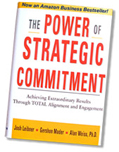
Most leaders believe that it takes between six and 12 months, or longer, to develop a strategy. They mistakenly think that the criteria for a meaningful strategy are the amount of research and market analysis that goes into it, and the time spent vetting it with experts.
But our observation is that how well communicated a strategy is, is far more important than how logical or well researched it is. The effectiveness of any strategy is directly proportional to the level of ownership, commitment and accountability among the executive team. A strategy is only as good as the levels of commitment the people who are accountable to fulfilling it, possess.
Here are the essential fours steps necessary to create total strategic commitment and alignment.
Step one: Do a commitment audit and tell the truth about the current levels of ownership, commitment and accountability within the organization. Ask people to be blunt about the degree to which they understand – and believe in – your current strategic plan.
Step two: Craft a bold and compelling future. Help your leadership team roll the clock forward two to three years from now. What is a clear, concise and well-articulated 15- to 20-word statement that describes what you are committed to building as an organization?
Step three: Define your specific success criteria. What are the three, four or five key measurable outcomes that will let you know you have reached that future state?
Step four: Get everyone on board with these. This means cascading the process through the ranks of management, sharing the content of the strategy with all levels of staff and listening to and addressing issues of competence, sincerity and courage.
Remember, the issue is not, “What is the right solution?” but, “What will people buy into, take ownership for, believe in and commit to?” When staff buy into a strategy, it’s because they trust their leaders are telling the truth about the need for it, they believe that their leaders have the courage and resolve to address the real issues, and they have faith their leaders are competent to do what needs to be done in order to implement the strategy.
On top of this, when staff feel cared for, concerned about and respected, they will naturally support and contribute to the strategy being realized.
How much buy-in do you have for your current company strategy? We would love to hear your comments.


Nice a posting. Common drawback can be G. change their own mind far too frequently.